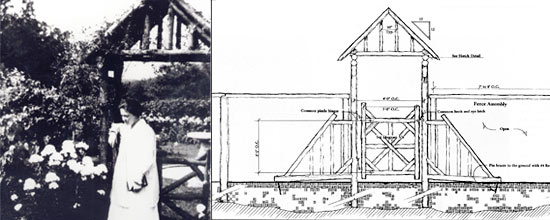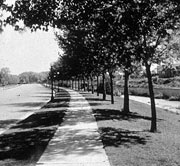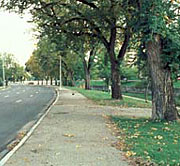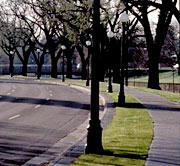

Guidelines for Restoring Cultural Landscapes
Structures, Furnishings, + Objects

Identify, Retain, and Preserve Historic Features and Materials from the Restoration Period
![]()
Identifying, retaining and preserving existing structures, furnishings and objects from the restoration period prior to beginning project work. Documenting the relationship of these features to each other, their surrounds, and their material compositions.
Evaluating the condition of structures, furnishings and objects from the restoration period. For example, utilizing Historic Structures Reports and aerial photography to understand the relationship between tracks, trestles and screens at a mining site.
![]()
Executing project work that impacts structures, furnishings and objects from the restoration period, without undertaking an “existing conditions” survey. For example, altering a pale fence that delineates the limits of a corral cluster.
Executing project work without understanding its impact on structures, furnishings and objects from the restoration period. For example, removing picnic tables and fireplaces from a group camp.
Protect and Maintain Features and Materials from the Restoration Period
![]()
Protecting and maintaining buildings, structures, furnishings and objects from the restoration period by use of non-destructive methods in daily, seasonal and cyclical tasks. For example, cleaning leaf litter from the gutters of a park pavilion.
Maintaining mechanical, plumbing and electrical systems for structures and furnishings. For example, providing adequate ventilation in a dovecote and improving its energy efficiency.
![]()
Failing to undertake preventive maintenance of structures, furnishings and objects from the restoration period. For example, allowing a cast iron fence from the restoration period to deteriorate.
Utilizing maintenance methods which destroy or degrade structures, furnishings and objects from the restoration period. For example, using harsh grit blasting techniques to clean historic stone or bronze statuary.
Allowing mechanical systems to fall into a state of disrepair, resulting in changes to a structure, furnishing or object. For example, enclosing mechanical systems of a poolhouse so they are not adequately ventilated.
Repair Features and Materials from the Restoration Period
![]()
Repairing deteriorating structures, furnishings and objects from the restoration period by reinforcing the materials that comprise these features. Repairs will also generally include the limited replacement in-kind or with compatible substitute material, of those extensively deteriorated or missing parts of features when there are surviving prototypes, such as roof features, windows, bollards and signage. The new work should be unobtrusively dated to guide future research and treatment.
![]()
Replacing or destroying structures, furnishings and objects from the restoration period when repair of materials and limited replacement of deteriorated or missing parts are appropriate.
Using a substitute material for the replacement part that does not convey the visual appearance of the surviving parts of the structure, furnishing or object from the restoration period, or that is physically or environmentally incompatible. For example, replacing a wood slat with a recycled plastic one in a historic bench.
Replace Extensively Deteriorated Features from the Restoration Period
![]()
Using existing physical evidence of form, material and detailing to reproduce structures, furnishings or objects from the restoration period. If using the same kind of material is not technically, economically, or environmentally feasible, then a compatible substitute material may be considered. The new work should be unobtrusively dated to guide future research and treatment. For example, replacing a cast stone mileage marker.
![]()
Removing a structure, furnishing or object from the restoration period that is unrepairable and not replacing it; replacing it with a new feature that does not convey the same visual appearance; or failing to document the new work. For example, replacing a deteriorated pier with a floating dock.
Remove Existing Features from Other Historic Periods
![]()
Removing or altering structures, furnishings and objects from other historic periods.
Documenting structures, furnishings and objects from other periods prior to their alteration or removal. If possible, selected examples of these materials or features should be stored to facilitate future research.
![]()
Failing to remove structures, furnishings and objects from another period, thus confusing the depiction of the cultural landscape during the restoration period. For example, maintaining modern sculpture in a historic estate.
Failing to document structures, furnishings and objects from other historic periods that are removed or altered so that a valuable portion of the historic record is lost.
Re-Create Missing Features from the Restoration Period
![]()
Recreating a missing structure, furnishing or object that existed during the restoration period based on historical, pictorial and physical documentation. For example, recasting a garden jardiniere from its original mold or duplicating a corn crib from an extant prototype.
![]()
Constructing a structure, furnishing or object that was thought to have existed during the restoration period, but for which there is insufficient information; or constructing a bandstand that was part of the original design but was never executed, thus creating a false historic appearance.
The missing garden gate at Weir Farm National Historic Site in Wilton, Connecticut, was restored through photographic documentation and archeology. ( NPS and Weir Farm National Historic Site)



The signature historic street lights, unique to Denver, Colorado, had been lost over time to quick-fix solutions. As part of a city-wide project to restore original streetscape furnishings, historic fictures were re-cast, and installed in their appropriate settings. An example is the single-globe fixtures along Speer Boulevard. (Foster and Marshall)